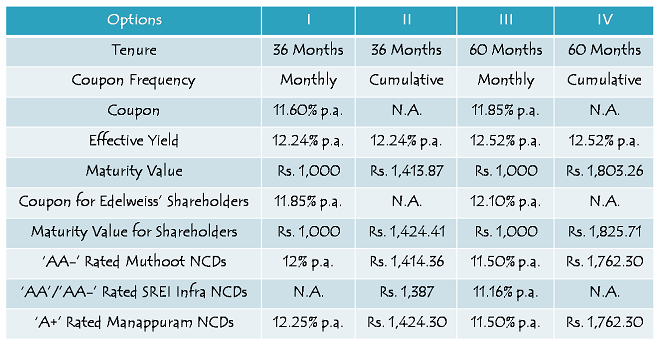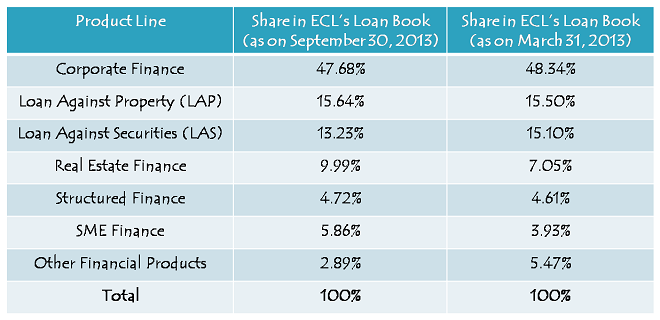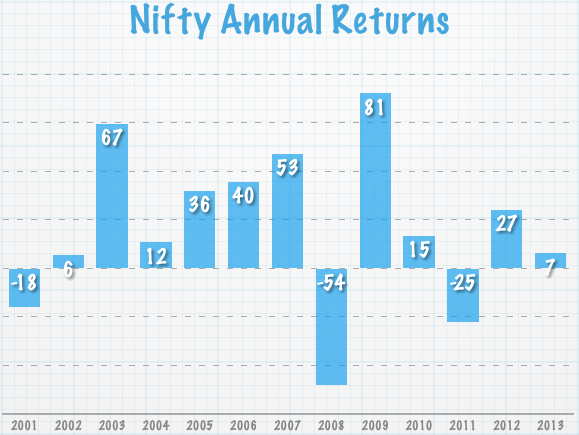This post is written by Shiv Kukreja, who is a Certified Financial Planner and runs a financial planning firm, Ojas Capital in Delhi/NCR. He can be reached at skukreja@investitude.co.in
Rashesh Shah promoted Edelweiss Financial Services’ 79.28% subsidiary, ECL Finance Limited is going to launch its public issue of secured, redeemable, non-convertible debentures (NCDs) from January 16th i.e. the coming Thursday. ECL Finance has issued such NCDs earlier also, but only through private placements. So, this is the first such public issue of NCDs by the company.
The issue will remain open for just eight days from January 16 and is scheduled to get closed on January 27, which is a Monday.
Size & Objective of the Issue – ECL Finance plans to raise Rs. 500 crore from this issue, including the green-shoe option of Rs. 250 crore. The company plans to use the proceeds for various financing activities including lending and investments, to repay existing loans, for capital expenditures and other working capital requirements.
Coupon Rates & Tenors on Offer – The company has decided to issue these NCDs for a duration of 36 months and 60 months. For 36 months, it is offering 11.60% per annum rate of interest, payable either monthly or at the end of this period on a cumulative basis.
For 60 months, it is going to pay 11.85% per annum, again payable either monthly or on a cumulative basis on maturity.

Higher Coupon Rate for Edelweiss Shareholders – ECL finance has decided to offer an additional 0.25% p.a. to the shareholders of Edelweiss Financial Services, its promoter company. So, even if you hold one equity share of Edelweiss, which closed at Rs. 28.80 per share on January 13, you are going to get this additional rate of interest.
But, you need to keep a couple of clauses in mind before you get attracted to this extra rate. One, you need to be a shareholder in the records of Edelweiss, on the deemed date of allotment as well as on the record date(s) i.e. both the dates.
Two, you are going to get this additional interest only on the lower number of NCDs held by you on the deemed date of allotment and the record date(s). So, if you buy some more NCDs from the secondary markets, you are not going to get the additional interest. Also, if you sell some NCDs after you get them in the initial allotment, you are going to lose out on this additional interest on those NCDs.
Interest Payment – With monthly option of interest payment, due interest will be paid on the first day of every month, except Sundays and public holidays on which commercial banks are closed in Mumbai.
Categories of Investors & Allocation Ratio – The investors have been classified in the following three categories and each category will have the below mentioned percentage fixed in the allotment:
Category I – Institutional Investors – 20% of the issue is reserved
Category II – Non-Institutional Investors – 20% of the issue is reserved
Category III – (i) “Unreserved Individual Portion” including HUFs – 20% of the issue is reserved
Category III – (ii) “Reserved Individual Portion” including HUFs – 40% of the issue is reserved
Resident Indian individuals or HUFs, investing Rs. 10 lakhs or less, would fall under the “Reserved Individual Portion” and those who invest more than Rs. 10 lakhs would come under the “Unreserved Individual Portion”.
NCDs will be allotted on a first come first served basis.
NRI not Allowed – Non-Resident Indians (NRIs), foreign nationals and qualified foreign investors (QFIs) among others are not eligible to invest in this issue.
Rating of the Issue – The issue has been rated by CARE and Brickwork Ratings and both have assigned it a ‘AA’ rating. Brickwork Ratings has a ‘Stable’ outlook for the issue.
Demat & TDS – Demat account is not mandatory to invest in these bonds as the investors have the option to apply these NCDs in physical form as well. Also, though the interest income would be taxable with these bonds, NCDs taken in demat form will not attract any TDS.
Listing, Premature Withdrawal & Put/Call Option – The company is going to get its NCDs listed on the Bombay Stock Exchange (BSE) only. The investors will not have the option to redeem these bonds back to the company before the maturity period gets over, but they can always sell these bonds on the BSE anytime they want. Liquidity remains low with these NCD issues though.
There is neither any put option with the investors of these bonds nor there is a call option with the company to pay back early.
Minimum Investment – The investors will be required to apply for at least 10 NCDs in this issue which makes it a minimum investment of Rs. 10,000.
Profile of ECL Finance Limited
ECL Finance is the 79.28% subsidiary of Edelweiss Financial Services Limited. Rest of its shareholders include Edelweiss Commodities Services Limited holding 7.77%, Edelweiss Securities Limited holding 5.15% and Waverly Pte Limited, an affiliate of GIC Singapore, holding 7.80% in the company as on November 30, 2013. It is one of the forty seven (47) subsidiaries of Edelweiss Financial Services Limited.
ECL Finance is into the business of lending and has diversified product line, including short-term/long-term finance to the corporates, loan against property & securities, financing to the real estate developers and small & medium enterprises (SMEs), ESOP financing, IPO financing, loan against mutual fund units/bonds etc.

 (Note: Figures are in Rs. Crore)
(Note: Figures are in Rs. Crore)
Relatively speaking, I think this issue looks better to me as compared to the other issues of Muthoot Finance, Manappuram Finance, SREI Infra and even India Infoline Housing Finance Limited (IIHFL). ECL Finance has a diversified product portfolio and backing of a reputed promoter group. Its financial position also looks healthy.
But, again I think that the investors in the higher tax bracket are better off investing in tax-free bonds rather than these taxable NCDs. Investors, who are not liable to pay any taxes and who can bear some risk of investing their money with a private company, can consider these NCDs for their investment.
Application Form of ECL Finance NCDs
Note: As per SEBI guidelines, ‘Bidding’ is mandatory before banking the application form, else the application is liable to get rejected. For bidding of your application, any further info or to invest in ECL Finance NCDs, you can contact me at +919811797407


